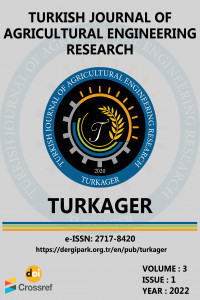Evaluating the Effects of Milling Speed and Screen Size on Power Consumed During Milling Operation
Evaluating the Effects of Milling Speed and Screen Size on Power Consumed During Milling Operation
Electrical energy, Milling, Power, Screen size Fish feed and rotor speed, Kernel size,
___
- Adeomaya SO and Samuel OD (2014). Design and development of a petrol-powered hammer mill for rural Nigerian farmers. Journal of Energy Technologies and Policy, 4(4): 65-74.
- Aderemi AM, Adedipe JO, Aluko KA, Odetoyinbo AP and Raji AA (2020). Development of a multi seed pneumatic cleaner. Journal of Multidisciplinary Engineering Science and Technology, 7(9): 12617-12624.
- Chambliss CG (2002). Forage moisture content testing. AG-181. University of Florida cooperative extension service, University of Florida, Gainesville.
- Donnel H (1983). Farm power and machinery. McGraw Hill, New Delhi, India. Anon. 1980. Encyclopedia Britanica, Vol. 21, pp.1157-72. William Benton, Chicago, IL, USA.
- Norazatul HM, Nyuk LC and Yusof YA (2015). Grinding characteristics of Asian originated peanuts (Arachis hypogaea L.) and specific energy consumption during ultra-high-speed grinding for natural peanut butter production. Journal of Food Engineering, 152: 1-7.
- Ovie SO and Eze SS (2013). Lysine requirement and its effect on the body composition of Oreochromis Niloticus fingerlings. Journal of Fisheries and Aquatic Science, 8: 94-100.
- Pyarelal SP, Swapnil CW, Gaurav RD, Akash GC, Vogita DK and Shradh HB (2017). Deshelling of “Semecarpus anacardium” (Bibba Seed): A review study. International Journal of Advance Research and Innovative Ideas in Education, 3(2): 1432-1439.
- Udo IU and Umoren UE (2011). Nutritional evaluation of some locally available ingredients uses for least-cost ration formulation for African Catfish (Claris gariepinus) in Nigeria. Asian Journal of Agricultural Research, 5: 164-175.
- Yayın Aralığı: Yılda 2 Sayı
- Başlangıç: 2020
- Yayıncı: Ebubekir ALTUNTAŞ
Evaluating the Effects of Milling Speed and Screen Size on Power Consumed During Milling Operation
Ademola ADENIGBA, Samuel Dare OLUWAGBAYIDE
Hilary UGURU, Ovie AKPOKODJE, Goodnews Goodman AGBI
Ide PATRICK EJIKE, Ikoko OMENAOGOR
Optimization of Mechanical Oil Expression from Sandbox (Hura crepitans Linn.) Seeds
David ONWE, Adeleke Isaac BAMGBOYE
Adewale SEDARA, Emmanuel ODEDİRAN
Chemical Coagulation: An Effective Treatment Technique for Industrial Wastewater
Aijaz Ali PANHWAR, Aftab KANDHRO, Sofia QAİSAR, Mudasir GORAR, Eidal SARGANİ, Humaira KHAN
Prediction the Performance Rate of Chain Type Trenching Machine
Mathematical Modeling of Food Processing Operations: A Basic Understanding and Overview
Manibhushan KUMAR, Siddhartha VATSA, Mitali MADHUMİTA, Pramod K PRABHAKAR
Multipurpose Fruit Juice Machine for Preventing Fruit Wastage in Nigeria Villages
Effects of Different Carbonization Conditions on the Color Change of Biochar
